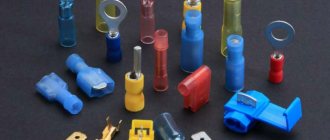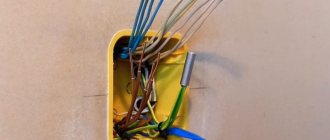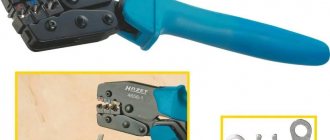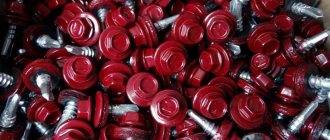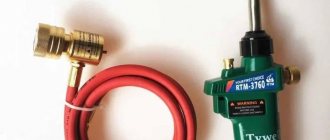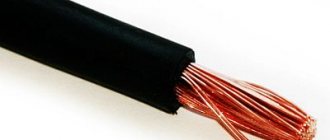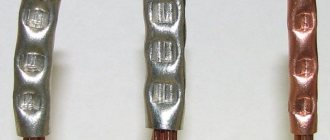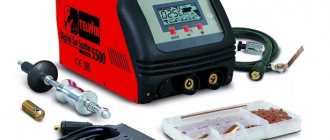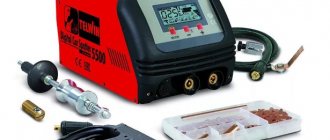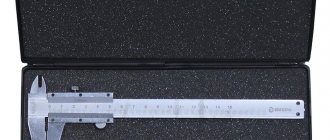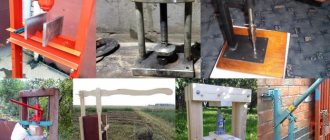A very useful and easy-to-use device that allows you to quickly and efficiently connect cables and wires when performing electrical installation work both in industrial and domestic conditions are crimping pliers. Using them, you can create high-quality and reliable connections of both mono- and multi-core wires, as well as network cables, even without the skills and experience in performing such procedures.
Connecting, terminating or branching wires using crimping is widely used in electrical installation practice.
What are crimping pliers?
The active development of electrical engineering and electronics has led to the fact that manufacturing companies working in this field have developed many special devices that allow electrical installation work to be carried out quickly and efficiently. One of these devices is crimping pliers, which are used to connect electrical wires. In addition, press pliers (or crimpers) are also used for crimping tips that perform the functions of contact elements of electrical cables and wires.
Due to their versatility, press pliers for crimping sleeves are actively used by various specialists. In particular, wire crimping pliers are actively used by radio amateurs, electricians and auto mechanics; they allow you to crimp conventional electrical cables and install elements of contact groups for non-standard connectors. Affordable, easy to use, reliable and efficient, crimping pliers are by far the most common tool for crimping cable lugs and connecting electrical wires using special sleeves.
Press pliers for ferrules with adjustable crimping pressure
Instead of an epilogue
Based on the analysis of the market for the instruments under consideration, it was established that almost all of its niches are occupied by models from a foreign manufacturer. If in the budget segment you can still find Russian samples, with fairly good characteristics and at a normal price, then at higher levels they simply do not exist. At the same time, it is worth noting that the entire premium segment is completely “occupied” by samples from the German company. This brand has existed since 1885 and it is not surprising that it managed to completely capture the top positions. However, the price of Knipex tools is very “biting” - it is simply impossible to find their crimper-type device specifically for tips with a price of less than 10,000 rubles. However, if such a crimper was nevertheless found, then it is essentially a banal fake.
Design features and principle of operation
Most modern models of press pliers designed for crimping tips and sleeves have a similar design and include:
- punch - a movable element that exerts pressure on the connecting sleeve or cable tip;
- matrix - a stationary part into the working cavity of which a cable lug or sleeve is placed before crimping it;
- handles, the action of which creates pressure on the element being crimped (most handles of modern crimping pliers are equipped with plastic or rubber pads for ease of use of such a tool);
- a ratchet mechanism built into the handles (the purpose of such a mechanism is to provide a full cycle of crimping performed using manual press pliers: thanks to it, their working jaws will not open until the crimping is completely completed and will not close repeatedly until they are completely opened).
Principle of wire crimping
The principle by which a manual press for crimping cable lugs and sleeves works is quite simple. Pressure is applied to these elements, which are previously placed in the working cavity of the crimping pliers matrix, with a punch. As a result, the contact element is compressed around the wire placed in its interior. The quality of the contact created during the crimping process depends on two factors: how correctly the size of the replacement matrix is chosen, and on the amount of pressure exerted by the crimping pliers on the element being processed.
There are three types of crimping of tips and connectors
Pliers for crimping tips and sleeves, as a rule, have several working sockets with dies of different sizes. Each of these sockets, marked in different colors, is designed to work with tips and sleeves of a certain diameter. This design solution allows you to use one tool for crimping contact elements of different diameters, without wasting time on replacing dies. The configuration of the working cavity of the crimping pliers matrix, depending on the model of such a tool, can be square or trapezoidal. Accordingly, the contact elements acquire the same shape after they are compressed.
The working body of crimping pliers are special dies with various cutouts that provide the desired shape of the crimped tip.
Color coding of tips
Color marking is used for NShVI tips. The color of the connector skirt corresponds to a specific wire cross-section:
- black – 1.5 mm2;
- blue – 2.5 mm2;
- gray – 4 mm2;
- yellow – 6 mm2;
- red – 10 mm2.
Color marking table for NShVI tips
Crimping wires using pliers cannot compare with hand twisting or soldering in terms of quality and speed of connections. For any connections you can always choose the right crimper model.
Main varieties
Modern manufacturers offer various modifications of crimping pliers, which may differ in both design and functionality. So, depending on the main purpose, two types of such instruments are distinguished:
- press pliers designed for stripping insulation from electrical wires and cables;
- tool for crimping tips and sleeves.
Press pliers for stripping insulation from conductors
Tools belonging to the first category are also usually divided into the following types:
- manual crimper is a fairly simple design, but effective device, which can be used to crimp cable lugs and sleeves of various sizes, as well as install contact connectors and terminals (some models are equipped with special blades installed in the place where the handles are attached; the presence of such blades in the design pliers can also be used to cut electrical cables and wires);
- electric pliers are a tool intended for primarily professional use (it is possible to use such universal pliers not only for crimping cable lugs and connecting sleeves of insulated and non-insulated type, but also for stripping insulation from electrical conductors);
- crimpers are tools with which you can install connectors and crimping lugs for wires, as well as crimp twisted pair cables (such pliers are equipped with two long handles, of which either one or both can be movable, a massive working part consisting of two working jaws, between which there are sockets for cables and wires of a certain diameter; the design of certain models of crimpers may also contain blades used for cutting electrical cables and wires).
Crimper for crimping ferrules with a set of replaceable dies
To perform crimping, a manual hydraulic press and electrically driven equipment can also be used.
Different models of crimping pliers used as a crimper for tips and sleeves may differ from each other in the shape of the working sockets, as well as the presence or absence of plastic flanges in such sockets.
The use of a crimper for tips and sleeves, the working sockets of which are equipped with such flanges, allows you to crimp stranded conductors with its help more efficiently.
Depending on the type of contact elements that the pliers are designed to work with, such a tool may be one of the following types:
- press pliers designed for crimping insulated sleeves;
- a crimping tool used to crimp connecting pipes that are not covered with insulation.
Tool for standard non-insulated terminals
The crimper for insulated terminals has a different jaw profile for neat crimping of the terminal without damaging the PVC tube
The design of the first type of crimping pliers has three oval-shaped working sockets, each of which is marked with its own color - yellow, red and blue. Insulated sleeves, for crimping which this type of pliers are used, are produced in the same color, so choosing the appropriate working socket for them is not difficult. In order to form high-quality and reliable contact between the tube and the electrical conductor placed in it when using such crimping pliers, the following nuance must be taken into account: the edge of the joint during the crimping process should be located in the middle of the upper profile of the working jaws of the crimping pliers.
The punch of crimping pliers, intended for working with non-insulated sleeves, is a metal rod, which must be located at the dividing joint during crimping. Thus, the compression of the connecting tube when using a tool of this type is carried out in its central part.
Types of sleeves
Before crimping the cores of wires and cables, it is necessary to select the correct sleeve. It is customary that in technical documentation many details have an abbreviation. Let's take a quick look at them. Sleeves for crimping wires are:
As you guessed, copper sleeves are used for crimping copper wires. Copper sleeves are divided into two types: GM and GML.
The abbreviation GM stands for “copper sleeve”. This is an ordinary copper sleeve, not coated or treated with anything (outwardly it resembles an ordinary piece of copper-colored tube).
The abbreviation GML stands for “tinned copper sleeve”. GML sleeves undergo tinning, their surface is covered with a special tin-bismuth layer. This layer protects the liner from corrosion and oxidation. We all know that copper tends to oxidize, and tinning prevents this. Thus, during crimping, the copper wires and the tinned sleeve do not react with each other (do not oxidize).
In my practice, I have met craftsmen who connected aluminum wires using GML sleeves. When asked why you do this, they answered “well, the sleeve is tinned.” In their opinion, due to the tin layer there is no direct contact of copper with aluminum. I still don’t recommend doing this, because when deformed, the top layer of the liner is damaged, and corrosion in this case is a matter of time. Then go and look for where the contact was lost, you can still inspect the twist somehow, but you will only have to bite off the sleeve.
Aluminum sleeves are designated in the documentation as GA “aluminum sleeve”; they must be used if aluminum wires are connected.
Combined sleeves, or aluminum-copper sleeves as they are also called, are designed for butt jointing of copper and aluminum wires. Combined sleeves have the abbreviation GAM and stand for “aluminum-copper sleeves”. It’s very convenient when, say, you need to extend the wires with the old wiring.
An aluminum wire is inserted into the sleeve on one side and a copper wire on the other. In a combined sleeve, the copper part is connected to the aluminum part using friction welding (do not try to repeat this at home).
Another type of GSI sleeves. the abbreviation stands for “insulated connecting sleeve”. GSI are a regular tinned sleeve coated with polyvinyl chloride (PVC) insulation. Using such sleeves, stranded copper wires are connected. When crimping wires, there is no need to remove the insulation; pliers are put on top of the insulation and a press is made.
Crimping process
In order to crimp tips and sleeves using crimping pliers, no special knowledge and skills are required; to do this, it is enough to familiarize yourself with theoretical information on this topic and try to perform this procedure yourself at least once. So, to make high-quality contact, you need to use the following algorithm:
- It is necessary to free the end of the cable or wire from the insulation to a length of approximately 1–1.5 cm, for which you can use crimping pliers of the appropriate design. On their lower working jaw there is a semicircular groove into which the wire is laid, and on the upper jaw there is a blade that cuts the insulation layer to the required depth. The process of stripping the insulation is as follows: after the wire is laid in the groove, the jaws are brought together and the crimping pliers make several turns around the wire, as a result of which the insulation on it is cut. It can then be easily removed.
- After the cores of the electrical cable or wire are stripped of their insulation, they must be placed in the internal cavity of the cable lug or connecting tube. It is very important that the contact element is correctly selected according to the diameter of the internal hole. The conductor strands must fit tightly into the cavity of such a contact element, then the compression will be performed efficiently.
- The contact element, into which the wire cores, stripped of insulation, have already been inserted, is placed in the corresponding working socket of the crimping pliers. After this, you need to smoothly close the handles of the tool until the ratchet mechanism is activated.
The process of crimping a copper tip
Cleaning the insulation
Insert the wire into the lug
Place the tip in the work area
Squeeze the handles of the press pliers
We get a pressed tip
Working area number on the reverse side
Many home craftsmen who have never encountered electrical work before are wondering how to crimp wire lugs without tools. If you don't have crimping pliers on hand, you can use simple tools such as pliers, a hammer or even a chisel, but only as a last resort. The fact is that this can damage both the cable lug or connecting sleeve and the conductor on which they are installed. In addition, the use of non-specialized tools instead of crimping pliers does not guarantee high-quality and reliable contact of the conductor with the tip or sleeve.
Coaxial connectors for crimping BNC, TNC, SMA, SMB, SMC, F
Coaxial radio frequency connector (RF connector, Radio frequency connector) - designed to connect a coaxial cable to equipment and to connect two coaxial cables together. There are two types of connectors: plugs (male part, “male”) and sockets (female part, “female”). Coaxial connectors typically require two crimps, one on the center pin and one on the braided sleeve.
BNC connector (Bayonet Neill-Concelman)
Most common, widely used in video and radio frequency (RF) applications for 2.4 GHz networks, 10BASE2 Ethernet, cabling, network cards and instrumentation. BNC connectors are installed on coaxial cable with a diameter of up to 8 mm (RG59, RG58, RG-6, RG-51).
BNC Crimp Coaxial Connectors
TNC connector (Threaded Neill-Concelman)
BNC connector version with threaded connection. Operates at frequencies up to 12 GHz. Used in antennas.
TNC type crimp coaxial connectors
SMA connector (Sub-miniature version A)
One of the most common RF/microwave connectors. Operates up to 12.4 GHz, and possibly up to 18 or 24 GHz. Used in avionics, radar and microwave communications. The plug (male connector) has a 7.925 mm hex nut, internal threads and a raised contact. SMA connectors are rated for 500 plug/disconnect cycles when the nut is properly tightened. For correct tightening, a torque wrench is required (0.3-0.6 N•m for copper connectors and 0.8-1 N•m for steel).
SMA type crimp coaxial connectors
SMB connector (Sub-miniature version B)
This is a smaller version of SMC and they are smaller than SMA. Has a snap-on coupling. Designed for frequencies from 2-4 GHz, but can operate up to 10 GHz. SMBs are mounted on cables: 3mm/1.7mm (outer/inner diameter) and 2.2mm/1.0mm (outer/inner diameter).
SMB type crimp coaxial connectors
SMC connector (Sub-miniature version C)
It is a small screw version of the SMA. Used up to 10 GHz, primarily in microwave environments. Fixed with thread. The connectors can be coated with a layer of gold, nickel, silver or other metals. They are used to connect Wi-Fi equipment with antennas and in microwave devices with increased requirements for vibration protection. Diameter of compatible coaxial cable: 2mm to 3mm.
SMC type crimp coaxial connectors
F - connector
Designed for television equipment. The cheapest high frequency connector available today. Operating frequency up to 2150 MHz. F-type connectors are usually installed on coaxial cable with a diameter of up to 7 mm. Connectors for cables with a diameter of up to 11 mm use a special insert and a nozzle on the central core.
F-type crimp coaxial connectors
Crimping profiles
Tool for crimping coaxial connectors BNC, TNC, SMA, SMB, SMC, F (crimpers and press pliers)
Tool for pressing BNC/RCA/F connectors onto coaxial cable
Coaxial cables and their characteristics
| Cable brand | Cable diameter, mm | Wave resistance, Ohm | Capacitance per unit, pF/m |
| RG-S | 8.4 | 52.5 | 93.5 |
| RG-SB | 8.4 | 50 | 96.78 |
| RG-6A | 8.4 | 75 | 65.62 |
| RG-8A | 10.3 | 50 | 100.07 |
| RG-9 | 10.7 | 51 | 98.42 |
| RG-9B | 10.8 | 50 | 100.07 |
| RG-10A | 12.1 | 50 | 100.07 |
| RG-11A | 10.3 | 75 | 67.26 |
| RG-12A | 12.1 | 75 | 67.26 |
| RG-13A | 10.8 | 75 | 67.26 |
| RG-14A | 13.8 | 50 | 98.42 |
| RG-16 | 16 | 52 | 96.78 |
| RG-17A | 23 | 50 | 98.42 |
| RG-18A | 24 | 50 | 100.07 |
| RG-19A | 28.4 | 50 | 100.07 |
| RG-20A | 30.4 | 50 | 100.07 |
| RG-21A | 8.4 | 50 | 98.42 |
| RG-29 | 4.7 | 53.5 | 93.5 |
| RG-34A | 16 | 75 | 67.26 |
| RG-34B | 16 | 75 | 70.54 |
| RG-3SA | 24 | 74 | 67.26 |
| RG-54A | 6.4 | 58 | 86.94 |
| RG-5SA | 5.5 | 50 | 96.78 |
| RG-55B | 5.2 | 53 | 93.5 |
| RG-S8 | 5 | 53.5 | 93.5 |
| RG-58C | 5 | 50 | 98.42 |
| RG-59A | 6.1 | 75 | 67.26 |
| RG-S9B | 6.1 | 75 | 68.9 |
| RG-62A | 6.1 | 93 | 44.29 |
| RG-74A | 15.6 | 50 | 98.42 |
| RG-83 | 10.3 | 35 | 144.36 |
| RG-213 | 10.3 | 50 | 96.78 |
| RG-218 | 23 | 50 | 96.78 |
| RG-220 | 28.4 | 50 | 96.78 |
Recommendations for choosing a tool
When choosing crimping pliers that you plan to use for crimping tips and sleeves, you need to pay attention to several basic parameters:
- crimping range (this parameter indicates the maximum and minimum diameter of the cable for crimping which this tool model is used);
- the presence of insulation on the handles of the tool and the material from which it is made;
- material for the manufacture of the tool itself and the elements of its working part.
In addition, when choosing crimping pliers, pay attention to the range of functionality of the tool and the brand under which it is manufactured.
Turned Pin Contacts (D-SUB)
Pin connectors are of very high quality and cost. Available in female and male configurations. Used in high density modular plugs and sockets. The crimp profile is usually square. Due to the small size of these connectors, crimping tools usually have special holders to secure the connector.
Turned Pin / D-Sub Contacts
Crimp profile
Tool for crimping Turned Pin and D-SUB contacts (crimpers and press pliers)
Modular plugs for RJ45, RJ11, RJ14, RJ25 interfaces
Registered Jack (RJ) is a standardized physical network interface that includes a male plug and a female port. Used for connecting telecommunications equipment. Although the leading edge of these connectors is largely standardized by international specifications, the body of the connector itself may vary from manufacturer to manufacturer. These connectors are not actually crimp connectors, but are IDC (Insulation Displacement Connectors) type connectors. IDC connectors have sharp pin contacts that, when the wire is pierced, strip off the insulation and come into contact with the conductor.
Modular connectors RJ9, RJ11/RJ12*, RJ45*
Standards and slang names for RJ connectors:
| Standard | Connector | Usage |
| RJ9* | 4P4C (4P2C) | Used to connect telephone handsets to the device. Width 7.5 mm |
| RJ11 | 6P2C | Used to connect two-wire telephones. |
| RJ12* | 6P6C | Designed for connecting six-wire telephone sets |
| RJ14 | 6P4C | Designed for connecting four-wire telephone sets |
| RJ22* | 4P4C (4P2C) | Used to connect telephone handsets to the device. Width 7.5 mm |
| RJ25 | 6P6C | Designed for connecting six-wire telephone sets |
| RJ45* | 8P8C | Used to build local area networks (LAN) |
| RJ45S | 8P4C with key | Used to connect modems. |
P is the number of places for conductors. C is the number of conductors in the connector. * There is no RJ-9 standard, this is the common name for 4P4C and 4P2C connectors * There is no RJ-12 standard, this is the common name for the RJ-25 (6P6C) standard * There is no RJ-22 standard, this is the common name for 4P4C and 4P2C connectors * Standard RJ-45 does not exist, it is the common name for the eight-wire 8P8C connector
Tool for crimping modular RJ connectors (crimper and press pliers)
